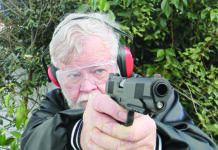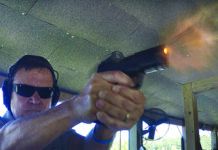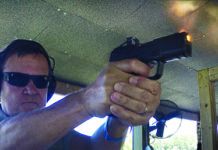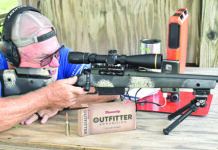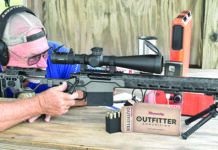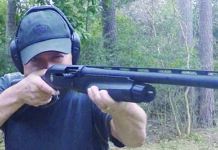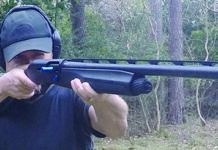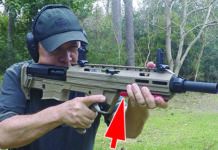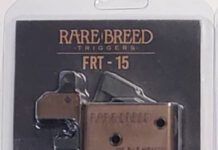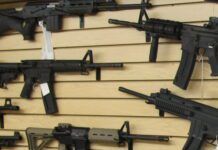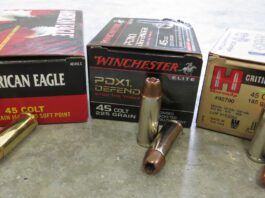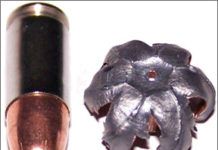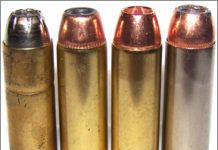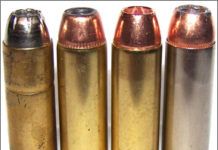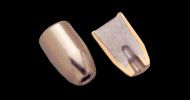Gauging 380 ACP Loads: FMJ May Be the Only Way to Go
Among the hot topics for discussion these days is the 380 ACP cartridge, more than one hundred years old and among the first of the modern smallbore pistol cartridges. Both the 38 ACP and the 32 ACP predate the 380, and each as originally introduced featured a small semi-rim for headspace. The 380 headspaces in modern fashion on the case mouth. Originally intended to perform as a pocket-pistol cartridge in early Colt and Browning pistols, the 380 Automatic Colt Pistol cartridge has enjoyed increasing popularity with the passage of reasonable concealed carry laws. Lightweight pocket pistols are the rage, and the 32 ACP and 380 ACP are popular numbers. The race to produce a maximum size savings in 380 ACP pistols has produced pistols in this caliber no larger than the equivalent 32 ACP chambering.The modern self-loading pocket pistol as we know it first came to be popular with the introduction of very well-made pistols around 1900. Browning, Colt, Dreyse, and Walther are among the better known names. The pocket pistol was designed to offer some measure of protection against thugs, robbers, muggers and the French "Apache." Their value was as much in threat as in potency. No one wants to get shot, especially with the complications of showing up at the hospital and explaining the wound. While the power of the pocket pistol is not impressive, any number of citizens, criminals and cops have been killed or crippled by these pistols. Then and now, some of the pistols are well made of good material and offer good function and reliability. It is also true that very poor designs and lax quality control are found among these pistols as well.A recent question we fielded was ammunition choice for the 380 ACP. A very experienced reader was concerned with penetration. If the JHP would not be counted on for penetration, he asked, would he be better off to load the pistol with full-metal-jacket ammunition? He wondered as to the effectiveness of the 380 ACP, although he mentioned that it would do for "cranial shots." If the bullet cannot be counted on to reach the vitals, then it would hardly be of much use even if it did expand. However, FMJ loads do not necessarily solve every problem. It is not well known, but a lightweight FMJ bullet is far more likely to stop short in penetration than a heavier bullet of moderate velocity. The smallbore bullets are also more likely to skid off bone. Often a heavier-for-the-caliber-bullet will penetrate more even at lower velocity. One of our raters has the distinction of having shot more vehicles than anyone else we are aware of. He has noted that the 9mm Luger 124-grain bullet penetrates more than the 115-grain load, even though the 124-grain bullet is slower. The 45 ACP 185-grain FMJ bullet does not penetrate as well as the 230-grain FMJ as a rule, even when loaded to higher velocity. A lighter bullet seems to be more easily turned. Even loading a full-metal-jacketed bullet in the 380 ACP is no guarantee of full penetration in a heavy jacket or to the vitals of a heavily muscled individual, as seen in the test table nearby.
Videos on GunReports.com!
Check out several videos this week: Watch a Ruger stainless 44 Mag lose its barrel due to metal fatigue. Larry Potterfield of MidwayUSA examines numerous gun stock blanks to illustrate what to look for when selecting a stock blank. From the NSSF, a quick run down of what to pack when you're heading out of town on that hunt of a lifetime.
A Hard Look at 9mm Luger Loadings: Speer, Fiocchi Win
Unquestionably the most popular military handgun cartridge of all time is the 9mm Luger. Originally used by Germany beginning in 1906 and universally adopted by the German Army in 1908, the 9mm Luger impressed the world enough that by 1950 the majority of the worlds armed services had chosen the 9mm Luger as a service cartridge. The hodgepodge of bottlenecked .30s and short-cased 9mms were put away by the efficiency of the 9mm Luger. America clung to the 1911 45 ACP largely because we had millions on hand. By 1954, the Browning High Power, French MAC 50, Beretta 1951 and Smith & Wesson Model 39 had set the pace for modern service pistols. By 1990 the 9mm was also the universal law-enforcement caliber. A few diehards clung to the 357 Magnum, and the 45 was used by a few agencies. The major agencies have since went to the 40 S&W or 45 ACP, often after hard lessons, but the 9mm undoubtedly remains a success story.The question is, is the 9mm a good fight stopper? That question has many answers, and it depends upon who is doing the asking. In military ball form, the 9mm has a reputation for needing more than one hit to stop the majority of adversaries. The 9mm pucker and straight-through shot does not have the desired effect on motivated adversaries. The historical reference is too well proven to argue against. Remember, these are soldiers firing full-size service pistols with full-power ball ammo. A civilian firing a compact pistol and common generic ball is far less well armed. Also, the 9mm has proven problematic in police service, and the 40 and 45 have replaced the 9mm in many agencies. Notably, agencies using certain loads, such as the +P+ Winchester SXT, have few, if any, complaints concerning the 9mm. And there is the rub. The 9mm is very load sensitive. With the best loads, the 9mm may approach the effectiveness of the legendary 357 Magnum. With poorer loads, the 9mm is little better than the 38 Special. Until the basic laws of physics are changed, no smallbore will be able to do the work of a big bore. Only actual damage and wound potential may be measured. Energy drop, stretch cavities and shock are not reliable predictors of effectiveness. The advantages of the 9mm are many, but frontal diameter and weight are not among them.On the plus side, the 9mm is easy to use well. It has all of the recoil that the average occasional shooter can handle, particularly in lightweight carry guns. The 9mm is an efficient cartridge for its size, packing what punch it has into a light package. The 9mm handguns have an impressive reserve of ammunition, with even the compacts often carrying 10 to 15 rounds of ammunition. A continuing thread in many of the discussions we have with professionals is that if they want the best wound potential, they carry a 45, but if they want a lot of shots, they carry a 9mm. We know of few professionals that carry the 40 on their own time and their own dime.With the shortcomings and advantages of the 9mm mapped out, we chose the cartridge for close scrutiny in wound ballistics. We would compare the expansion and penetration qualities of several loads. Some of the criteria are objective and some subjective. Some may prefer a heavy bullet, others a light bullet. This is subjective. But the objective criteria is this-the load must be reliable. Only a consistently reliable load with good feed reliability and good primer seal and case mouth seal is suitable for service use.Elsewhere, in general the 9mm hollowpoints offer less penetration than the big bores, but more relative expansion. A number of years ago the FBI found the penetration of the 9mm 115-grain JHP lacking during a critical incident. They adopted the 147-grain JHP as an alternative. All of us do not have a need to shoot through car doors and light cover, but some of the 115-grain loads exhibit the minimum of penetration most of us are comfortable with. The 124-grain JHP is a compromise of sorts that many find offers the ideal balance of expansion and penetration. When testing the 9mm loads, the range of performance impressed us. The standard-pressure loads in particular were very consistent, with little to choose from among them-but this was not the case when we tested +P loads and particularly when considering the range of bullet weights.Over time, we have tested bullets weighing from 88 to 147 grains. Weve found the 9mm ran a 100% variation in penetration, with some loads penetrating as little as 7 inches and others well over 14 inches. For our testing, we have come to a consensus that personal-defense ammunition should exhibit penetration of 12 inches and expansion to 1.5 diameters. We are willing to compromise to an extent when the cartridge needs extra help with expansion for effectiveness. After all, some of the 9mm cartridges that have performed so well in Federal service, such as the +P+ 115-grain JHP, are light on penetration.In this installment, we are testing eight loadings. Seven are popular standard-pressure loadings, and we have included one +P load for comparison. Each has proven popular among shooters, and reader feedback demanded we test this class of 9mms. The competitors include the MagTech 92.6-grain First Defense, the MagTech 115-grain JHP Guardian Gold (the only +P tested), the Fiocchi 115-grain XTP, the Speer Gold Dot in both 115- and 124-grain weights, the Fiocchi 124-grain XTP, the Hornady 115-grain Critical Defense, and the Remington 124-grain Golden Saber.After much firing and comparison, the 115-grain bullets offered the greatest expansion, and a smallbore cartridge really needs expansion. Given adequate penetration, expansion is important. The expansion and penetration balance inherent in the Gold Dot 115-grain load made it a subjective winner. Accuracy was topnotch, tied with the 124-grain Fiocchi for first place. Among the 124-grain loads, the consistent results of the Fiocchi 124-grain XTP loading are also considered excellent performance. The greater balance of penetration may sway some of us to choose the 124-grain load.In the end, it is marksmanship that will carry the day, but some loads have advantages over the other. In coming installments we are going to consider the performance of +P rated loads and also the heavyweight 147-grain loads, revisiting these results as we compare the popular 9mm loadings.Here are the Report Card grades for these rounds:
A Hard Look at 9mm Luger Loadings: Speer, Fiocchi Win
Unquestionably the most popular military handgun cartridge of all time is the 9mm Luger. Originally used by Germany beginning in 1906 and universally adopted by the German Army in 1908, the 9mm Luger impressed the world enough that by 1950 the majority of the worlds armed services had chosen the 9mm Luger as a service cartridge. The hodgepodge of bottlenecked .30s and short-cased 9mms were put away by the efficiency of the 9mm Luger. America clung to the 1911 45 ACP largely because we had millions on hand. By 1954, the Browning High Power, French MAC 50, Beretta 1951 and Smith & Wesson Model 39 had set the pace for modern service pistols. By 1990 the 9mm was also the universal law-enforcement caliber. A few diehards clung to the 357 Magnum, and the 45 was used by a few agencies. The major agencies have since went to the 40 S&W or 45 ACP, often after hard lessons, but the 9mm undoubtedly remains a success story.The question is, is the 9mm a good fight stopper? That question has many answers, and it depends upon who is doing the asking. In military ball form, the 9mm has a reputation for needing more than one hit to stop the majority of adversaries. The 9mm pucker and straight-through shot does not have the desired effect on motivated adversaries. The historical reference is too well proven to argue against. Remember, these are soldiers firing full-size service pistols with full-power ball ammo. A civilian firing a compact pistol and common generic ball is far less well armed. Also, the 9mm has proven problematic in police service, and the 40 and 45 have replaced the 9mm in many agencies. Notably, agencies using certain loads, such as the +P+ Winchester SXT, have few, if any, complaints concerning the 9mm. And there is the rub. The 9mm is very load sensitive. With the best loads, the 9mm may approach the effectiveness of the legendary 357 Magnum. With poorer loads, the 9mm is little better than the 38 Special. Until the basic laws of physics are changed, no smallbore will be able to do the work of a big bore. Only actual damage and wound potential may be measured. Energy drop, stretch cavities and shock are not reliable predictors of effectiveness. The advantages of the 9mm are many, but frontal diameter and weight are not among them.On the plus side, the 9mm is easy to use well. It has all of the recoil that the average occasional shooter can handle, particularly in lightweight carry guns. The 9mm is an efficient cartridge for its size, packing what punch it has into a light package. The 9mm handguns have an impressive reserve of ammunition, with even the compacts often carrying 10 to 15 rounds of ammunition. A continuing thread in many of the discussions we have with professionals is that if they want the best wound potential, they carry a 45, but if they want a lot of shots, they carry a 9mm. We know of few professionals that carry the 40 on their own time and their own dime.With the shortcomings and advantages of the 9mm mapped out, we chose the cartridge for close scrutiny in wound ballistics. We would compare the expansion and penetration qualities of several loads. Some of the criteria are objective and some subjective. Some may prefer a heavy bullet, others a light bullet. This is subjective. But the objective criteria is this-the load must be reliable. Only a consistently reliable load with good feed reliability and good primer seal and case mouth seal is suitable for service use.Elsewhere, in general the 9mm hollowpoints offer less penetration than the big bores, but more relative expansion. A number of years ago the FBI found the penetration of the 9mm 115-grain JHP lacking during a critical incident. They adopted the 147-grain JHP as an alternative. All of us do not have a need to shoot through car doors and light cover, but some of the 115-grain loads exhibit the minimum of penetration most of us are comfortable with. The 124-grain JHP is a compromise of sorts that many find offers the ideal balance of expansion and penetration. When testing the 9mm loads, the range of performance impressed us. The standard-pressure loads in particular were very consistent, with little to choose from among them-but this was not the case when we tested +P loads and particularly when considering the range of bullet weights.Over time, we have tested bullets weighing from 88 to 147 grains. Weve found the 9mm ran a 100% variation in penetration, with some loads penetrating as little as 7 inches and others well over 14 inches. For our testing, we have come to a consensus that personal-defense ammunition should exhibit penetration of 12 inches and expansion to 1.5 diameters. We are willing to compromise to an extent when the cartridge needs extra help with expansion for effectiveness. After all, some of the 9mm cartridges that have performed so well in Federal service, such as the +P+ 115-grain JHP, are light on penetration.In this installment, we are testing eight loadings. Seven are popular standard-pressure loadings, and we have included one +P load for comparison. Each has proven popular among shooters, and reader feedback demanded we test this class of 9mms. The competitors include the MagTech 92.6-grain First Defense, the MagTech 115-grain JHP Guardian Gold (the only +P tested), the Fiocchi 115-grain XTP, the Speer Gold Dot in both 115- and 124-grain weights, the Fiocchi 124-grain XTP, the Hornady 115-grain Critical Defense, and the Remington 124-grain Golden Saber.After much firing and comparison, the 115-grain bullets offered the greatest expansion, and a smallbore cartridge really needs expansion. Given adequate penetration, expansion is important. The expansion and penetration balance inherent in the Gold Dot 115-grain load made it a subjective winner. Accuracy was topnotch, tied with the 124-grain Fiocchi for first place. Among the 124-grain loads, the consistent results of the Fiocchi 124-grain XTP loading are also considered excellent performance. The greater balance of penetration may sway some of us to choose the 124-grain load.In the end, it is marksmanship that will carry the day, but some loads have advantages over the other. In coming installments we are going to consider the performance of +P rated loads and also the heavyweight 147-grain loads, revisiting these results as we compare the popular 9mm loadings.Here are the Report Card grades for these rounds:
San Francisco Eyes Ammunition Registry; CCRKBA Vows Lawsuit
The revelation that the City of San Francisco might consider an ammunition registry scheme brought a promise from the Citizens Committee for the Right to Keep and Bear Arms that a lawsuit would quickly follow.
GunReports.com Video: Ruger Tactical Tips – 1: Mental Preparation
Before self-defense training can begin, you must mentally prepare yourself for combative situations. This series is a collection of self-defense tips with career law enforcement officer Dave Spaulding designed to help individuals learn proper skills and techniques to defend themselves.
Personal Defense 45 Colt Loads: Some Are Sedate, Others Sizzle
When we speak of big-bore handguns and the calibers that begin with a 4, the 45 Colt cartridge is among the most respected. (Sometimes the 45 Colt is called the 45 Long Colt, we wont rehash that one here.) The 45 Colt in its original loading was introduced in 1873. This hoary old cartridge is the oldest centerfire handgun cartridge still in common use. The 45 Colt was designed as a martial cartridge. While we usually view handguns as short-range personal defense tools, the 45 Colt cartridge was often used at longer range in fighting aboriginal opponents. The cartridge was reputed to be capable of taking down an Indian war pony at 100 yards. The 45 Colt cartridge earned its reputation as a defense cartridge the hard way-not through opinion, but through front-line use. Aside from the Army and Marine Corps, the Texas Rangers, the Royal Canadian Mounted Police and the New York State Patrol were just a few users of the 45 Colt cartridge.It is interesting that there are currently three and perhaps four power levels loaded in the 45 Colt. Two we are not concerned with. First, there are ultra-hot loads designed for hunting revolvers. The Ruger Blackhawk and the Freedom Arms 454 Casull will handle such loads. Your Uberti would probably be turned into a hand grenade. The second class of loading we are not concerned with are Cowboy loads. These usually use a 250- or 255-grain bullet running at 800 fps or less. We have clocked these loads as slow as 650 fps. While in the .455 Webley class, these are not loads we deem suitable for personal defense.For much of its service life in the West, the 45 Colt was castrated by expedient. To make the same load usable in both the short cylinder "backup issue" Smith & Wesson 45 Schofield and the 45 Colt, the Schofield, a shorter, less powerful cartridge, was the general issue cartridge for both revolvers. One of our raters remarked that this is most interesting because today the 45 Colt standard loads and the 45 Colt +P defense loads offer much the same relationship. When we are testing 45 Colt +P loads, we are testing loads suitable for use in the Taurus Judge, Smith & Wesson double-action revolvers, and the strong US Fire Arms (USFA) single-action revolvers and the Ruger Vaquero. These are not Ruger Blackhawk-only loadings, but neither are they pipsqueaks.The original 45 Colt full-power load pushed a 255-grain conical bullet to more than 900 fps. Today, outdoorsmen use a standard handload of a 250-grain semi-wadcutter at about 1000 fps. While this is a powerful load, a personal-defense load should use an expanding bullet for greater wound potential and also to limit penetration in the interest of public safety. It is interesting to note that although there are revolvers in this caliber available in the double-action format from Ruger, Smith & Wesson, and Taurus, there are few defensive loads available. We were able to test four loads from three different makers.
Personal Defense 45 Colt Loads: Some Are Sedate, Others Sizzle
When we speak of big-bore handguns and the calibers that begin with a 4, the 45 Colt cartridge is among the most respected. (Sometimes the 45 Colt is called the 45 Long Colt, we wont rehash that one here.) The 45 Colt in its original loading was introduced in 1873. This hoary old cartridge is the oldest centerfire handgun cartridge still in common use. The 45 Colt was designed as a martial cartridge. While we usually view handguns as short-range personal defense tools, the 45 Colt cartridge was often used at longer range in fighting aboriginal opponents. The cartridge was reputed to be capable of taking down an Indian war pony at 100 yards. The 45 Colt cartridge earned its reputation as a defense cartridge the hard way-not through opinion, but through front-line use. Aside from the Army and Marine Corps, the Texas Rangers, the Royal Canadian Mounted Police and the New York State Patrol were just a few users of the 45 Colt cartridge.It is interesting that there are currently three and perhaps four power levels loaded in the 45 Colt. Two we are not concerned with. First, there are ultra-hot loads designed for hunting revolvers. The Ruger Blackhawk and the Freedom Arms 454 Casull will handle such loads. Your Uberti would probably be turned into a hand grenade. The second class of loading we are not concerned with are Cowboy loads. These usually use a 250- or 255-grain bullet running at 800 fps or less. We have clocked these loads as slow as 650 fps. While in the .455 Webley class, these are not loads we deem suitable for personal defense.For much of its service life in the West, the 45 Colt was castrated by expedient. To make the same load usable in both the short cylinder "backup issue" Smith & Wesson 45 Schofield and the 45 Colt, the Schofield, a shorter, less powerful cartridge, was the general issue cartridge for both revolvers. One of our raters remarked that this is most interesting because today the 45 Colt standard loads and the 45 Colt +P defense loads offer much the same relationship. When we are testing 45 Colt +P loads, we are testing loads suitable for use in the Taurus Judge, Smith & Wesson double-action revolvers, and the strong US Fire Arms (USFA) single-action revolvers and the Ruger Vaquero. These are not Ruger Blackhawk-only loadings, but neither are they pipsqueaks.The original 45 Colt full-power load pushed a 255-grain conical bullet to more than 900 fps. Today, outdoorsmen use a standard handload of a 250-grain semi-wadcutter at about 1000 fps. While this is a powerful load, a personal-defense load should use an expanding bullet for greater wound potential and also to limit penetration in the interest of public safety. It is interesting to note that although there are revolvers in this caliber available in the double-action format from Ruger, Smith & Wesson, and Taurus, there are few defensive loads available. We were able to test four loads from three different makers.
GunReports.com Video: Ruger Tactical Tips – 2, Handgun Fundamentals
On GunReports.com, this Ruger video covers the essentials. Learning grip and body position are crucial to controlling your firearm's recoil. Dave Spaulding puts special emphasis on trigger control for managing your gun, as well as other essentials like grip and body position.
9mm Is Overwhelming ‘Yes’ Choice in GunReports Survey
(GunReports.com) -- A recent tabulation of 529 respondents to a GunReports.com survey question, “Is the 9mm suitable for self defense?” showed a strong preference for the round. However, almost all respondents added comments to qualify their 'yes' votes.
McDonald Supreme Court Ruling Strikes Down Chicago Gun Ban
(GunReports.com) -- In its second major ruling on gun rights in three years, the Supreme Court Monday extended the federally protected right to keep and bear arms to all 50 states. Justice Samuel Alito wrote for the five-justice majority, saying 'the right to keep and bear arms must be regarded as a substantive guarantee, not a prohibition that could be ignored so long as the States legislated in an evenhanded manner.'
GunReports.com Video: Ruger Tactical Tips Part-7: Proper Training (2:49)
GunReports.com presents a Ruger video: Proper training is essential for good gun technique. This series is a collection of self-defense tips with career law enforcement officer Dave Spaulding designed to help individuals learn proper skills and techniques to defend themselves.



